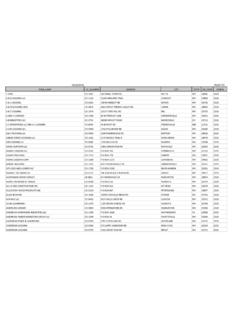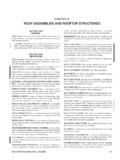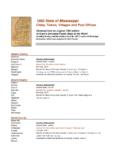Transcription of ASCE 7-10 wind loads - SAFTSE – Safety Advocates For ...
1 See discussions, stats, and author profiles for this publication at: 7-10 wind loadsArticle April 2011 DOI: (401)126 CITATIONS3 READS24,3874 authors, including:Some of the authors of this publication are also working on these related projects:Making the ARA HurLoss model available to subscribing Lloyd's Market Association members through theOasis platform in partnership with Boat Services, Ltd. View projectRonald A CookUniversity of Florida25 PUBLICATIONS 401 CITATIONS SEE PROFILEP eter J VickeryApplied Research Associates, PUBLICATIONS 1,904 CITATIONS SEE PROFILEAll content following this page was uploaded by Peter J Vickery on 11 February user has requested enhancement of the downloaded file. All in-text references underlined in blue are added to the original documentand are linked to publications on ResearchGate, letting you access and read them immediately.
2 ASCE 7-10 wind loads Ronald Cook1, Larry Griffis2, Peter Vickery3, Eric Stafford4 1 Civil and Coastal Engineering, University of Florida, 2 Structures Division, Walter P. Moore and Associates, 3 Applied Research Associates, 4T. Eric Stafford & Associates, ABSTRACT ASCE 7-10 Minimum Design loads for Buildings and Other Structures contains several changes regarding wind loads . The major editorial change is a complete reorganization to a multiple-chapter format as done previously for seismic loads with the objective being to make the provisions easier to follow. Technical changes include the introduction of new wind speed maps to be used with a load factor for LRFD and a load factor for ASD, the reintroduction of Exposure D for water surfaces in hurricane -prone regions, and revised wind -borne debris regions.
3 A new simplified procedure for buildings up to 160 ft has been added based on the provisions for buildings of all heights. INTRODUCTION The major changes to the wind load provisions of ASCE 7 introduced in ASCE 7-10 are: Reorganization of wind load provisions wind speed maps Re-introduction of Exposure D in hurricane -prone regions wind -borne debris region Simplified procedure for buildings 160 ft This paper presents a general background on the basis for these changes. Thirty other changes related to wind loads were included in ASCE 7-10. The majority of these changes were editorial but some did include technical changes. These include: Minimum wind loads Improved exposure and roughness examples Revisions to low-rise envelope method Rooftop equipment REORGANIZATION OF wind load PROVISIONS The wind load provisions of Chapter 6 in ASCE 7 have been reorganized into 6 new Chapters.
4 In recent years, there has been much discussion about the layout and presentation of the wind load provisions in ASCE 7. While, ASCE 7-98 did make some improvements to the format (introduction of the 3 Methods), much of the important information was buried deep within the paragraph numbering. In addition, Method 2 Analytical Procedure actually contained several analytical methods embedded within the section ( , Buildings of All Heights and Low-rise Buildings). While the provisions were technically correct and properly numbered, understanding and applying the appropriate wind loads could be somewhat cumbersome. The primary goals of the reorganization effort were to keep the section numbering smaller and to locate major subject areas as distinct chapters. Additionally, it was desired to order the wind provisions in a logical sequence for the general structural design community.
5 Accomplishing these goals led to the creation of 6 distinct chapters and the relocation of the provisions into their most logical new chapter. For example, the provisions for determining MWFRS loads are in separate chapters from Components and Cladding. Additionally, the different methods for determining MWFRS loads are located in the 3 separate chapters Chapter 27 Directional Procedure (formerly buildings of all heights in Method 2); Chapter 28 Envelope Procedure (formerly low-rise buildings in Method 2); and Chapter 29 Other Structures and Building Appurtenances (formerly embedded in Method 2). Each chapter was again subdivided into parts where deemed appropriate for clarity. For example in Chapter 28 the analytical method for determining wind loads for low-rise buildings is identified as Part 1 and the simplified method for determining wind loads for low-rise buildings is identified as Part 2.
6 Similar subdivisions occur in Chapters 27 and 30. To ease the transition to the new format and to facilitate improved awareness of the provisions applicable to the various methods, each chapter and parts contain tables that specifically identify and outline the steps and provisions applicable for that respective chapter or part. Table shown below is an example of one of the outlines presented for Part 1 in Chapter 27. Additionally, a table was added to the commentary that provides a cross-reference of all sections, figures, and tables between ASCE 7-05 and ASCE 7-10. Sections applicable to ASCE 7-05 are shown in the left column in numerical sequence so that users familiar the ASCE 7-05 may easily locate the applicable sections in ASCE 7-10. wind SPEED MAPS Multiple Maps.
7 The decision to move to multiple ultimate, limit state, or strength design wind speed maps to be used in conjunction with a wind load factor of for LRFD instead of using a single map coupled with an importance factor and a wind load factor of was made because: An ultimate or strength based map brings the wind design approach more in line with that used for seismic design in that they both essentially eliminate the use of a load factor for strength design. The multiple map approach eliminates the inconsistencies in the use of the importance factor that strictly varies with location and between the hurricane and non- hurricane regions. Table Steps to Determine MWFRS wind loads Enclosed, Partially Enclosed and Open Buildings of All Heights Step 1: Determine risk category of building or other structure, see Table Step 2: Determine the basic wind speed, V, for the applicable risk category, see Figure , B or C Step 3: Determine wind load parameters: wind directionality factor, Kd , see Section and Table Exposure category, see Section Topographic factor, Kzt, see Section and Table Gust Effect Factor, G, see Section Enclosure classification, see Section Internal pressure coefficient, GCpi, see Section and Table Step 4: Determine velocity pressure exposure coefficient, Kz or Kh, see Table Step 5: Determine velocity pressure qz or qh Eq.
8 Step 6: Determine external pressure coefficient, Cp or CN Fig. for walls and flat, gable, hip, monoslope or mansard roofs Fig. for domed roofs Fig. for arched roofs Fig. for monoslope roof, open building Fig. for pitched roof, open building Fig. for troughed roof, open building Fig. for along-ridge/valley wind load case for monoslope, pitched or troughed roof, open building Step 7: Calculate wind pressure, p, on each building surface Eq. for rigid buildings Eq. for flexible buildings Eq. for open buildings The new maps establish uniformity in the return period for the design basis winds, and they more clearly convey that information The new maps, by providing the design speeds directly, more clearly inform owners and their consultants about the storm intensities for which their designs are performed.
9 The hurricane importance factor specified in ANSI 1982 and ASCE 7-93 was eliminated from the 1995 Edition of ASCE 7 by incorporating it into the wind speed contours. Consequently, at no time since the introduction of ASCE 7-95 have the wind speed contours in the hurricane prone region been representative of a 50 year return period wind speed, although most users erroneously thought this was the case . In the development of the wind speed map used in ASCE 7-98 the wind load Task Committee (WLTC) re-visited the hurricane importance factor inherent in the Standard since 1982 primarily because it was recognized that the importance factor varied with location along the coast and using a constant value of was not appropriate. This spatially varying factor was incorporated into the map by dividing the 500 year wind speeds by the square root of the load factor, which at the time was expected to be , not the value of that was finally recommended by the load factor committee.
10 In ASCE 7-10, the approach taken to determine the return periods associated with different occupancy category importance factors began with the premise that the nominal wind load , computed using the methods given in ASCE 7-05, when multiplied by the wind load factor, represents a limit state or strength load . Furthermore, it was assumed that the variability of the wind speed dominates the calculation of the wind load factor. This is an approximation, and depends on the uncertainty in the various components of the wind loading chain (Davenport, 1983). The wind speed uncertainty is combined with uncertainties in pressure coefficient, exposure factor, gust factor and modeling errors. Since these errors combine as sums of squares, and because the uncertainty effect of the wind speed is doubled as it appears in the wind load equation as a pressure, the net result is the wind speed uncertainty contributes in the range of 70% to 80% of the total uncertainty.





